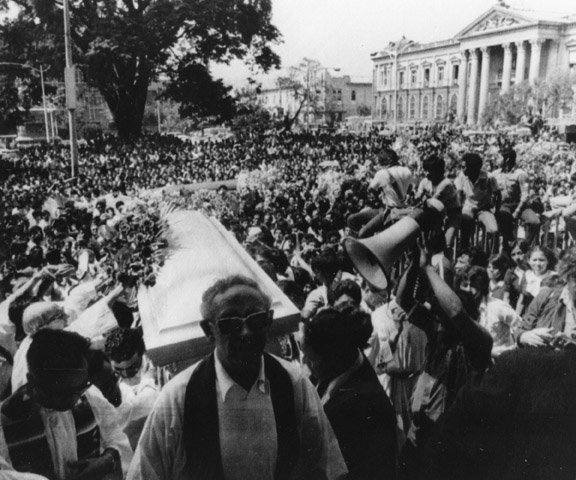
Thousands gather outside the Metropolitan Cathedral in San Salvador on March 30, 1980, as the casket of slain Archbishop Oscar Romero is carried inside for a funeral Mass. (Scan of CNS file photo)
Editor's Note: On March 30, 1980, three U.S. bishops, including Archbishop John Quinn of San Francisco, president of the National Conference of Catholic Bishops, attended the funeral of Archbishop Oscar Romero of San Salvador, El Salvador, who was assassinated March 24. For the 35th anniversary of the event, Catholic News Service is reprinting Quinn's account of the tragedy written upon his return to San Francisco. It originally appeared April 7, 1980; it has been edited for clarity and style.
I left San Francisco early on Saturday morning*, March 29. The plane arrived around 11:15 p.m. that night. We were met by a group of priests and seminarians and taken to Sacred Heart School, where we spent the night.
Although I had traveled alone to El Salvador, I arrived at the same time as several other foreign priests and bishops and some representatives of the National Council of Churches from New York. Among the foreign bishops were Bishop Eamon Casey of Galway, Ireland; Auxiliary Bishop James O'Brien of Westminster, England; Bishop William Connare of Greensburg, Pa., and Bishop James Hickey of Cleveland.
On Sunday morning after breakfast, we left at 9 o'clock to go to the basilica where the procession formed. It was a hot and sunny morning. The streets were filled with people who seemed relatively subdued, which matched the weather. There was not even the slightest breeze to alleviate the heat, although there was an occasional cloud to give brief relief from the bright sun.
At the basilica, I met Bishop Arturo Rivera Damas of Santiago de Maria, El Salvador, a bishop from Brazil and another from Ecuador. There were several more there and quite a large crowd in the basilica by the time the procession began to move at 10 a.m. We walked the better part of half an hour from the basilica to the cathedral. There we vested for the Mass and took our places on the front steps of the cathedral, where the Mass was to be celebrated.
I was standing next to the altar facing the immense crowd of perhaps 100,000 people. Next to me was Archbishop Marcos McGrath of Panama City. The crowd was singing hymns and listening to various instructions pertinent to the funeral Mass. Directly in front of the altar lay the casket containing the body of Archbishop Romero. It was surrounded by flowers, but on the top rested only a crucifix.
After some 15 minutes' wait, there was applause and cheering from the crowd signaling the arrival of Cardinal Ernesto Corripio Ahumada of Mexico City, who had come from Mexico as a special representative of Pope John Paul II. In a few moments, the Mass began. During the first reading of the Scriptures, I could see a long column of people marching down the right side of the square near the government buildings. They were quiet, but their left hands were raised as they walked. They were a body of leftist organizations and were carrying a wreath to be placed on the coffin.
At this point, the Boy Scouts, who were in charge of crowd control and who throughout this whole event performed heroically and with consummate skill, closed ranks to prevent the marchers from crossing in front of the area where the altar was set up. Even so, there was no disturbance.
One marcher was allowed to go up and place the wreath near the casket. The rest remained at the periphery of the square. The Mass then continued. Following the Gospel, Cardinal Corripio stood at the altar where he best could be seen by the people and where there was a microphone.
He was approximately two-thirds through his prepared sermon when suddenly there was a sound of gunfire, followed quickly by an explosion at the far right end of the square where the leftist groups had gathered. A sharpshooter had been sighted on top of one of the buildings in the square earlier.
It should be noted that Archbishop Romero was assassinated while he was celebrating Mass and struck down immediately after he had concluded his sermon. Similarly, the trouble on Palm Sunday began during the sermon of the cardinal. He had just quoted some of the remarks made by Pope John Paul II at the general assembly of the Latin American bishops in Puebla, Mexico, in 1979, and was concluding with the words of Archbishop Romero -- "We cannot love by hating. We cannot defend life by killing" -- when the shot rang out.
For a moment, there was an effort by the cardinal to bring calm to the crowd. But then a second explosion threw the crowd into panic. There was a great gasp as if to say, "What we feared most to happen has happened." The crowd swayed to the right and to the left for a moment and then broke ranks when someone near the altar said, "Into the cathedral."
I was only a few steps away from the main door. The crowd began to move toward the door, and instantly I was swept along by the force of thousands of people moving in the same direction. Between me and the door stood the cardinal's chair set on a small, elevated temporary platform.
I realized instantly that if the force of the crowd pushed me against the chair it would go over, and I would go down with it and be trampled to death. Suddenly someone removed the chair, clearing the access into the cathedral.
Within seconds, there were from 5,000 to 6,000 people inside the cathedral. We were packed up against one another as in the old movies of slave ships. It was impossible to move and very difficult for the elderly and children to breathe, both because of the intense heat and because so many of them are of small stature.
News reports which I have read said that nuns and priests were fainting. People certainly fainted. I saw no nuns or priests who fainted. On the contrary, the nuns and priests acted with a tremendous sense of responsibility for the people. Most of them were trying to comfort the people, to help them find a safer spot, to get water for them and to care for those who were injured, sick or in need of some medical attention.
Because of the circumstances and not knowing what might happen, I gave general absolution. A Maryknoll priest near me gave me absolution. We could do nothing to alleviate the situation. We were utterly powerless.
Across from where I stood in the huge crowd I could see a large picture of Our Lady of Guadalupe. I invited the people to join in praying the rosary, and we continued to pray throughout the ordeal.
I thought of an incident more than 100 years ago when Pius IX was visiting a school in Rome. While he was talking with the teachers and the students, the floor collapsed. The pope exclaimed, "Vergine Immacolata, aiutateci," an Italian prayer meaning "Immaculate Virgin, help us." No one was injured in the collapse of the floor.
Later, this became a favorite prayer of the Roman people, and later when I was a student in Rome, we often used it, too. It came at once to mind, and I said that prayer over and over again as we waited and wondered what would happen next and how it would all end.
There would be moments of calm and we would think that perhaps the violence was over. Then another bomb would explode or a gunshot would ring through the air. At one point, there was a sudden commotion in the crowd toward the front, the side door of the cathedral near the altar. A young girl in a red bandanna came in with a submachine gun. But eventually she left, and there did not seem to be anyone shot.
As we were huddled together in the sweltering heat, a corpse would be carried in from outside and brought over to the side wall. This happened a number of times. There were bodies lying on the front steps of the cathedral. It seemed that most of those who died were trampled or died from asphyxiation.
Among the people confined in the cathedral were foreigners such as Peter Bottomley, a member of the British Parliament, the foreign minister of Nicaragua, the cardinal of Mexico representing the pope and bishops from various parts of Europe, the United States and Canada.
In addition, there were Americans and other foreign news people. They continued to take pictures and seek interviews throughout the ordeal. A reporter from The New York Times spoke with me, and when we finished, I asked him if he would notify San Francisco that when he saw me last I was all right. When I returned, I learned that within the hour word had been received to this effect from the New York office of the Times.
There were a few telephones inside the cathedral for use by the Red Cross. They were very helpful. So I tried to reach the American Embassy in San Salvador, hoping to enlist some assistance to restore order and help the crowd. We were unable to make contact, no doubt due to the condition in the city at the moment.
Near the area where the phones were located was the burial place of Archbishop Romero. As the violence continued outside, the casket was carried into the cathedral and placed at once in the tomb. Cardinal Corripio then said the prayers of the burial, and the tomb was closed while gunfire and bombs continued to explode outside.
And so the waiting went on and on. We did not know whether someone would throw a bomb or sprinkle the crowd with machine gunfire. Still less did we know whether we would be detained as hostages.
After some two-and-a-half hours of this uncertainty, word began to circulate among the crowd that the bishops, priest and religious should go out first so that people would feel that it was safe to leave.
The chief targets of the violence were the bishops, priests and religious, and the reasoning was that if they were able to go back onto the square without being shot, it would be safe for the people. So we went out together and there was no more shooting.
A Red Cross ambulance drove us to the school where we were staying. It was almost 3:30. We were exhausted, drenched with sweat from the intense heat and immensely relieved that it was over and with as little loss of life as there was.
Who was responsible for this sacrilege, for this insult to humanity, for this unbelievable outrage on Palm Sunday?
Government reports from El Salvador first reported a "slight disturbance" during the funeral Mass. The blame was placed on the leftist elements.
The fact, however, is that the leftist elements, which we all saw clearly from the altar where I was standing, were peaceful. The fact is that the first bomb was thrown at them. Are we to believe that they threw the bomb at themselves? The fact is that, having put a wreath on the casket, they would not be likely then to disrupt the funeral.
The fact is that the oligarchy and the government seemed to be entirely absent from the funeral. Their presence, it would seem, would be a major reason for leftists to create a disruption, and this reason was lacking. A sharpshooter was seen standing on top of one of the government buildings in the square. Security troops were spotted at various points in the city that morning.
The situation is admittedly complex. There is the junta, the oligarchy and the leftist groups. In addition, there is the church. The church has a long-standing and well-developed social teaching going back to Leo XIII before the turn of the century and running through the Second Vatican Council, Medellin and Puebla. The latter, it should be remembered, was approved shortly after the final document was submitted to Pope John Paul II.
Fairness demands that room be allowed for exceptions, but the oligarchy as a group is extremely, fanatically rightist. It has never accepted the social teaching of the church and resists any effort at improving the situation of the poor of the country.
The junta is weak, and while it has made some efforts to improve the situation, for example by land reform, it is not strong enough to be in control of the military or of the oligarchy. The oligarchy would like to discredit and bring about the downfall of the junta and so restore its own hegemony.
All of this, in turn, only plays into the hands of the leftist groups who, with some legitimate grounds, can claim that they have no other course and that they are the only organized opposition to the shocking and widespread violation of human dignity and human civil rights.
Archbishop Romero rightly condemned the excesses and violence of all three groups and tried to bring them to respect human rights, to peace and to order for the sake of the whole nation and all of its people.
The enemies of Christ said he was a political figure, that he was seeking the crown when he spoke about the kingdom of God. When he worked miracles and fed the hungry or cured the sick, they said he worked in the power of the devil.
Similarly, when Archbishop Romero spoke about such indisputable biblical points of morality as "thou shall not kill," that every human individual created in the image of God has the right to live in freedom and human dignity with guaranteed civil rights, they said he was "interfering in politics" and that he was a "communist."
This is only another manifestation of the policies of some Latin American governments which use the expression "national security" to justify all forms of repression, including the random murder of citizens. The tactics of such governments are the very tactics we have associated and continue to associate with communist tyranny, tactics which must be denounced wherever they are found.
As Jesus did not let accusations that he was a political figure or in league with the devil deter him, so the bishops and the priests of El Salvador and of other countries will have to accept the ignominy of being called communists if that is necessary to be faithful to their obligation to proclaim the whole truth of the whole Gospel of Christ in all its power and with all its beauty. Rejection and insults are not the criteria of truth. Sometimes they are the lot of those who are faithful to the truth. For, ultimately, the truth will prevail.
While it is difficult for me as a foreign visitor to El Salvador to make a completely accurate assessment of what happened, what I saw and witnessed makes it impossible for me to subscribe to the report that leftists were the cause of the disaster.
A civil authority which makes no seeming effort to control a crowd or to restore order in such circumstances must at least be suspected of some kind of complicity. A government of a Catholic country and an oligarchy notably absent from the funeral of its own archbishop must also be suspected of some complicity.
The question then becomes not who is guilty but rather who is most guilty.
As I conclude these reflections, there come to mind the words of Pope John Paul II on the World Day of Peace:
"Violence flourishes in lies and needs lies. It seeks to gain respectability in the eyes of the world by pretexts that have nothing to do with reality and are often contradictory. ...
"We cannot sincerely condemn recourse to violence unless we engage in a corresponding effort to replace it by courageous political efforts which aim at eliminating threats to peace by attacking the roots of injustice.
"This is why I was able to say with such conviction at Drogheda in Ireland and why I now repeat, 'Violence is a lie, for it goes against the truth of our faith, the truth of our humanity. Do not believe in violence; do not support violence. It is not the Christian way. It is not the way of the Catholic Church. Believe in peace and forgiveness and love; for they are of Christ.'
"Truth is the driving power of peace because it reveals and brings about the unity of man with God, with himself and with others. Forgiveness and reconciliation are constitutive elements of the truth which strengthen peace and which build up peace. To refuse forgiveness and reconciliation is for us to lie and to enter into the murderous logic of falsehood." -- Pope John Paul II, Jan. 1, 1980.
*An earlier version of this story misstated the date.

